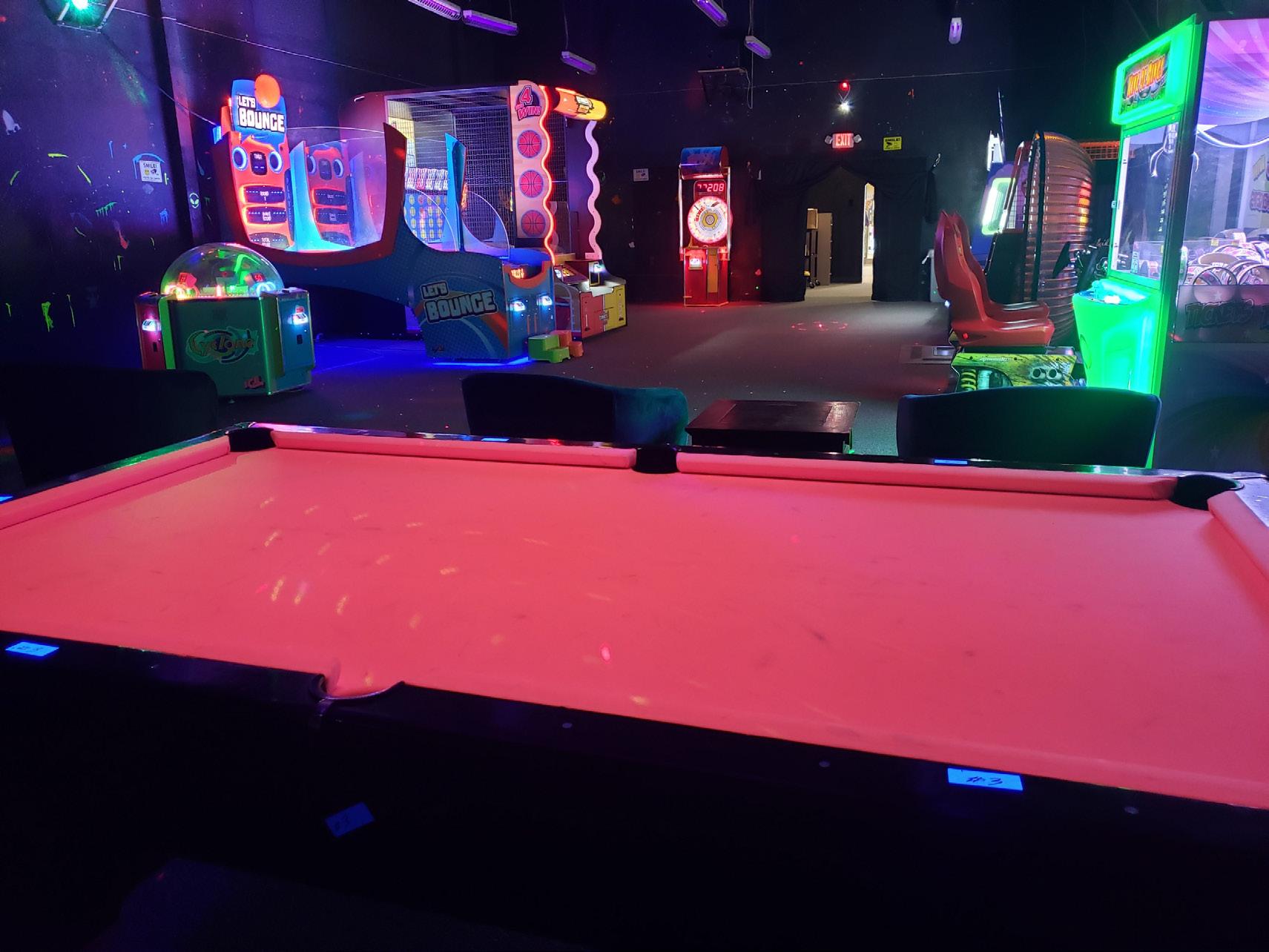




Eutauna Yocom smiled as I walked into Alvey’s Chocolates, which displayed rows of caramel apples, homemade fudge, toffees and truffles. I sampled some raspberry fudge, the flavor exploding in my mouth, as Yocom, the owner, made small talk with me.
Eventually, we moved to the topic of the Cache Valley Mall closing, and Yocom sighed. She started telling me about Alvey’s and her concerns about how her business will stay afloat.
“As a small business owner, it’s definitely going to be hard finding a place with as much foot traffic,” Yocom said. “This is our only location.”
In June, the Cache Valley Marketplace project was introduced to the Logan City Council. The plan would be, after demolition of the mall, to rebuild a 148,000 square foot store, along with 346 housing units and a 156-room hotel.

According to Yocom, the mall managers allegedly have not been upfront about when the mall will be officially closing, leading her to worry how her business will make the transition to work in other locations.
“It would be nice if we were given some information,” Yocom said.
But according to Addie Shirts, manager at Akita Ramen Poke and Boba, the mall’s managers have a reason for not disclosing as much information up front.
“There’s a lot of confounding factors here that make it really difficult to say definitively when it’s going to close,” Shirts said, noting the Logan City Council has had several meetings and discussions to rezone the area — which may delay the public’s knowledge of any definitive date.
The mall’s managers did not get back to the Statesman in time for this article’s publication, despite several attempts to contact them.
Despite having little knowledge about the future, many businesses are already making relocation plans, including local business Pure Oils.
Dae Hopson, one of the managers of Pure Oils, noted doing business in the mall is no easy task — especially with their space’s $2,000 monthly rent. With the mall closing, she’s not sure how the business will fare in the future.
“To be honest, I’m not sure if we’re going to find a place,” Hopson said. “There probably won’t be many places that will be (available) in Logan for a while.”
Hopson said she hopes she and Pure Oils’ other two
managers will be able to find a rental space that has a cafe adjacent to a shop — that way, customers could drink non-alcoholic beverages and have stand-up poetry nights, in addition to purchasing some oils and jewelry.
“We’re hoping if the stars align and everything works out, we’ll not only take this as an opportunity to have new product, but to provide a new part of the business to offer to the community,” Hopson said.
John Barrett, another manager at Pure Oils, affirmed even though he hasn’t received much information from the Cache Valley Mall managers as to the mall’s closing date, he’s confident the business will stay in Logan.
“I don’t know where we’re going to go, but we’re
the Herald Journal.
Despite Claire’s having two other locations in Logan’s local Walmarts, it won’t leave workers unaffected. For Lizzy Wright, a Claire’s employee and Utah State University student studying art education, the loss of the job and income will be difficult — and not just for her, but for the many college employees working in the mall.
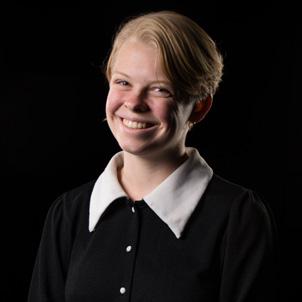
“I just think it might affect it quite a bit; this is pretty much the only place that college students can find that pays a little better than most,” Wright said.
It is still unclear as to whether GameStop will get another location, according to manager Ember Gonsalves.
“Just like everything else, they can’t really give confirmation about it,” Gonsalves said. “We hope so; it would be smart (to get another location), right, since we’re like the only GameStop within an hour in each direction.”
Gonsalves noted despite the announcement about the mall closing, foot traffic is still as busy as ever, and with the holiday season coming up, she’s not concerned.
Shirts agreed, adding several customers have expressed their concerns and support for her business.
“I think as time goes on, I’ve become less stressed about it, especially because I’ve seen how much interest the community has taken, not necessarily in the mall itself, but with the businesses in the mall,” Shirts said. “That makes me hopeful that something is going to happen.”
going to find somewhere to go,” Barrett said.
Fun Unlimited, one of the anchor stores in the mall, is also working to find affordable locations in Logan to relocate. With the store chock-full of comics, playing cards and books, it’s also “a good place to get old games,” said employee Kai Carver.
The business is trying to stay in Logan, Carver said, but if they don’t find another location to put their vast amounts of VHS tapes and Gamecube controllers, they will need to move to Ogden. So far, he said, there isn’t much more information on when they will relocate.
Larger chain stores like Bath & Body Works and Claire’s noted they will likely have other locations in Logan to operate out of, so there will be little concern for them.
Bath and Body Works will be opening their second location in Logan in October, along with several other businesses, including Five Below, Homegoods and Ulta Beauty on 49 E. 400 N., according to a report found in
Queer Christian Initiative, a new club at Utah State University aims to create a space for LGBTQ+ students to explore their spirituality.
QCI officially became a USU club in spring 2023.

“The goal is to provide a space for queer students of faith and allies to explore the intersection of their spiritual and queer identity and how these identities can work together,” said Morgan Boase, club secretary. “Finding a space where you know you won’t be judged for your identity or your religious beliefs and being able to discuss how those two can kind of work together in your life and not necessarily be two separate things has helped me.”
Becka Fagerburg, community liaison and board member of QCI, said growing up, there were times she felt like experiences with her religion and the LGBTQ+ community felt polarizing.
“I felt like I was getting messages from both spaces saying you couldn’t be queer and religious,” Fagerburg said. “You kind of have to be either all or nothing, and that’s not how I wanted to live my life.”
Fagerburg said when she found out QCI was coming to USU, she cried.
“It was just such a relief to me that there would be a space with people who were going through the same things I was and who had the same lived experience as me,” she said.
Boase said belonging to the LGBTQ+ community and dealing with feelings from their religious upbringing meant it was hard to try and reconcile faith with identity.
“I wanted to have a community and a space where I could explore that without feeling judgment from either side,” Boase said.
Fagerburg said QCI is not meant to replace either queer or religious spaces.
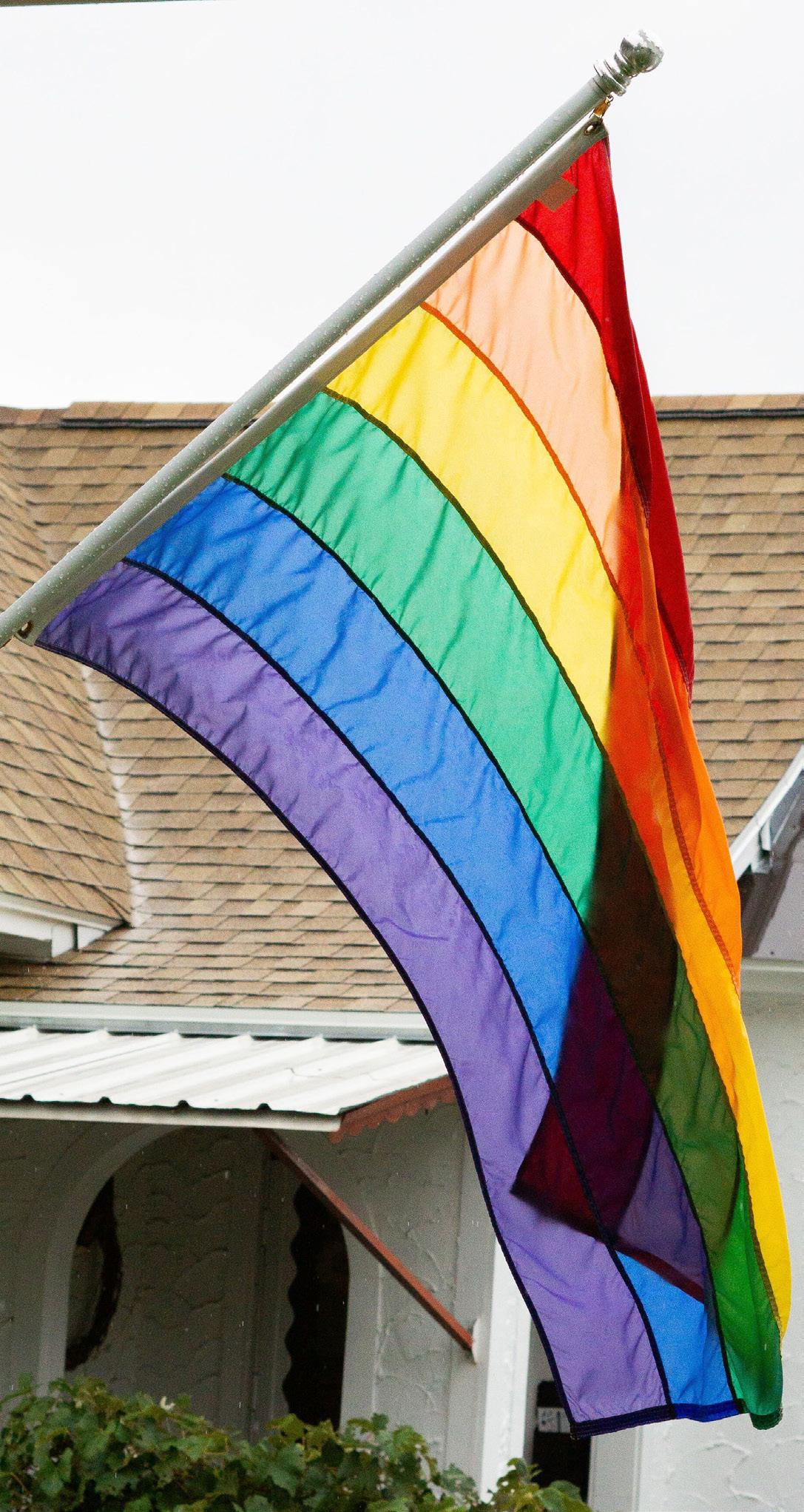
“We still love and really appreciate those queer and religious spaces and all
they bring, and we’re not the alternative to that or a replacement,” she said. “We’re just expanding that pool of thought.”
Boase said one way QCI will provide a safe space for students is by hosting spiritual and social activities each month.
“We’re planning on doing a seminar series at the end of October for three weeks where we will have a different speaker every week talk about their spirituality and queer journey and identity and how they’ve reconciled those or where they’re at,” Fagerburg said. She said the club wants to build a sense of community where students feel like they are valued and safe expressing who they are.
Boase said even though the club has “Christian” in its name, people don’t need to be religious to come to the activities.
“We really want to focus on having people of all faiths and spiritualities welcome,” Fagerburg said.
Fagerburg said regardless of how you identify, everyone can be respectful by listening to new ideas and being willing to learn.
“Just be open to hearing other ideas and hearing from people different from you, and don’t make negative assumptions about someone’s character based on their beliefs,” Fagerburg said. “You can love someone and learn from them and not compromise who you are and what you believe.”
— savannah.burnard@usu.edu
On Sept. 1, 2023, Brynja Kohler and Susannah French were welcomed as associate deans for the College of Science. Their roles include taking charge of 30 undergraduate degrees, and 20 graduate degrees.
The College of Science’s departments are as follows: Biology, Mathematics & Statistics, Chemistry & Biochemistry, Physics, Computer Science as well as Geoscience. Over 1,400 Aggies are studying in these programs.
Kohler graduated from the University of Utah with a Ph.D. in mathematical biology, and came to teach at USU in 2004. Prior to her career at USU, she attended the University of Chicago, as well as NYU.
Kohler’s love for science and mathematics extends back to her youth. Her mother was a secondary school teacher, and her father worked as a chemistry professor.
“My mother’s encouragement weighed heavily on me. She said we need more women in STEM, so I took her advice and just kept taking math classes until I became a math professor,” Kohler said.
Kohler assumes the role of associate dean for undergraduate programs and services following the departure of Greg Podgorski, professor of biology, who is retiring after 35 years with USU. He served as an associate dean for five years.
“He has been enormously supportive and helpful,” Kohler said.
In this role, she will be working directly with students with research and undergraduate pursuits.
“I just think there are so many wonderful studying opportunities for students,” Kohler said.
Kohler also enjoys working with young adults as they prepare for college.
“It helps me understand what goes on in high schools
8/29/23
-A bat was found at the Agricultural Sciences building. It was suspected to be dead, but later was found to be alive. Police could not do anything about it because bats are a protected species.
and then that transition into college, and how to be successful,” Kohler said.
During her time thus far at USU, Kohler has been named Teacher of the Year for the mathematics department in 2019, as well as Outstanding Graduate Mentor for the college in 2020.

Kohler’s time at USU and notable accomplishments have helped prepare her to step into this role.
“I’ve had great mentors here at USU, and I’ve been able to be involved,” Kohler said.
French is assuming the role of associate dean for research and faculty.
Named Faculty Researcher of the Year in 2022,
9/4/23
-Police responded to a request for a welfare check on an individual at Morgan Hall.
9/5/23
-A person became stuck in an elevator in Huntsman Hall. Police and USU facilities personnel responded and freed the person.
-A one-wheel was stolen, police located the stolen property and returned it to the owner.
French’s research capabilities will aid her in the new position.
“This role in particular is one where you have to understand the demands of research and the diversity of research,” French said.
She did not hesitate to praise her predecessor Michelle Baker.
“She in herself is an amazing researcher,” French said. “I’ve got a lot to live up to.”
French came to USU as an ecologist and has been with the university for seven years. She enjoys working with lizards from the Galapagos.
“Out of the classroom, you can learn so much,” French said.
French continues on working with USU’s undergraduate research program. The program is one of the oldest in the nation, started in 1975 and received the Award for Undergraduate Research Accomplishments in 2020. In total, USU has over 50 research programs.
French encourages all USU students, despite their major, to interact with science.
“It’s not just learning definitions of certain things, it’s about how you critically evaluate your environment, decisions you’re going to make and what’s going on around you,” French said.
Malory Rau is a sophomore studying social media, public relations, and marketing. When not skateboarding with friends, she is usually thrifting, reading, or seeing the latest movie.

— m.rau@usu.edu
9/6/23
-A dirty smoke detector alerted students, who then contacted USUPD dispatch. The fire marshal came to clean and reset the alarm.
9/9/23
-K-9 officer Zoomer performed a sweep of Maverik Stadium before the football game.

9/10/23
-Police located an individual with an outstanding warrant.
for students. It has also increased security for events by ensuring only students with an A-number are allowed entry.
With the launch of Transact, tickets for High Stakes Bingo sold out in two days. Many students were unaware tickets were being sold digitally this year, or thatthey were even available yet. Other students thought the app was just a one time thing and avoided downloading it altogether.
Smith shared some insight in response to these concerns.
“Next semester we have another bingo coming up in the spring we’re going to do a countdown so that students are more aware of when the tickets will be coming out,” Smith said. The countdown will be posted on social media through USUSA Events.
By Trystan Short NEWS REPORTEROn tuesday, Sept. 5, Utah State University Student Events, hosted the first event using the newly implemented ticketing system at High Stakes Bingo.
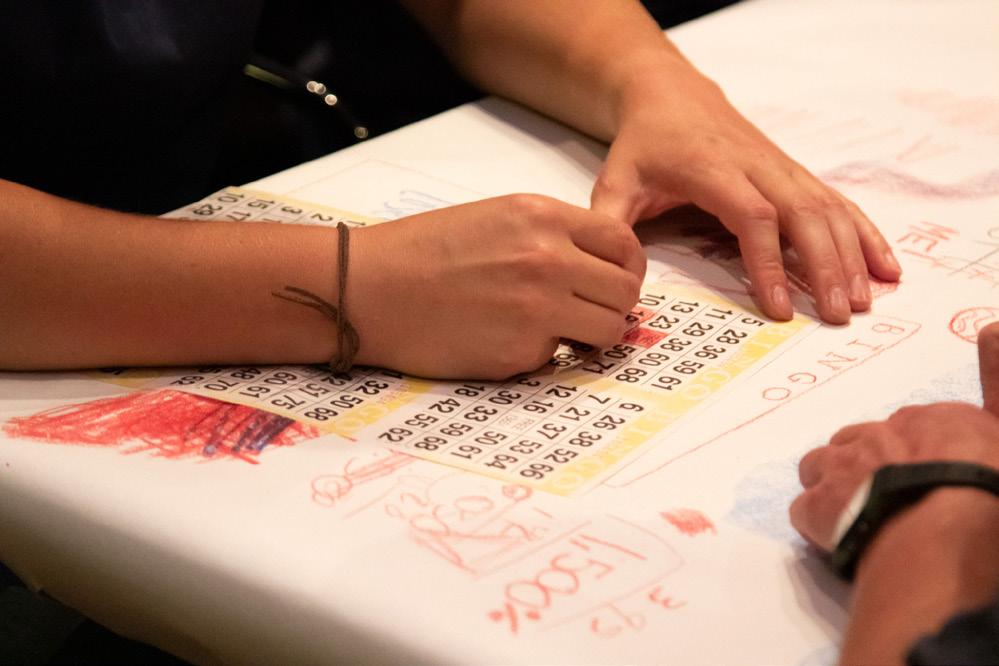
Students gathered on Tuesday night to take part in the Weeks of Welcome tradition. However, this year, students did not need a physical ticket to get through the doors, but rather a QR code on their phones that was scanned at the door.
The new system being used is called Transact Mobile Ordering, or Transact. It is an app students can download on their mobile devices and log into with their A-number. It is expected this app will be used for all future student events that require tickets. Transact allows students to get tickets to events like High Stakes Bingo in advance, without having to make the trip to the TSC Card Office.
First-year student Sydney Baird shared her experience learning about Transact and using it for the first time in a text correspondence.
“The new ticketing system was super easy to use. I was able to get my ticket super fast and the easy scan made it so you could get inside in a timely manner,” Baird wrote.
USUSA Events posted about the new app on their Instagram before the event.
Baird explained how easy it was to follow the directions that posted.
“I found out about the event from Instagram, and the instructions were there telling me exactly what to do,” Baird wrote.
Other students said a positive aspect of using Transact is they do not have to worry about losing a physical ticket before the date of the event.
USUSA traditions director for student events, Ashlynn Smith, had good things to say about Transact from an operations standpoint. One benefit of the new app is it allows USUSA to meet different ADA accommodations
For students who don’t use social media, Smith provided an alternative way to see the countdown.
“I’m utilizing MyUSU as a countdown as well. If people have their notifications on for that app, it’ll quickly be fed on (My USU app) like, ‘Tickets are available for our sixth bingo in 24 hours’,” Smith said. Smith also mentioned the idea of a text thread students would be able to subscribe to and receive updates for events on. This is another method USUSA Events would use to let students know when tickets
for events would be going live in the Transact app, and would urge them to act quickly to secure theirs.
Overall, this new ticketing system has proved beneficial from its first run. USUSA Events were able to fill the TSC Ballroom to capacity for both sessions of bingo. Students won big prizes, danced on chairs and most importantly, sang The Scotsman.

Students can look forward to painting the TSC bus loop on Oct. 2, the next event from the USUSA Events Traditions committee.
As for the next event using the new ticketing system, be sure to download Transact and watch your social media for updates on when tickets for the Mr. USU pageant will go live.
Trystan Short is a senior majoring in Technical Communication and Rhetoric while minoring in Journalism. She enjoys playing volleyball, listening to Taylor Swift, and cuddling with her cat —
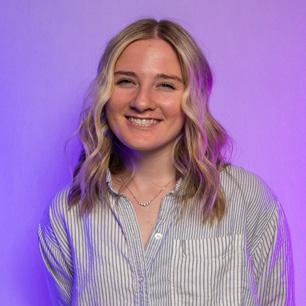
Facing Fire: Art, Wildlife and the End of Nature in the New West, the Nora Eccles Harrison Museum of Art’s featured exhibit this fall, depicts “burn art” and captures the emotions and damage that wildfires cause through photography, paintings and other art forms.

Shannon Erickson, the coordinator of learning and engagement at the on-campus museum, highlighted a part of the exhibit done by photographer Norma I. Quintana, whose house burned down. She lost almost everything, including her photography supplies.
Quintana carefully staged charred items on a rubber glove and photographed them with her phone camera.
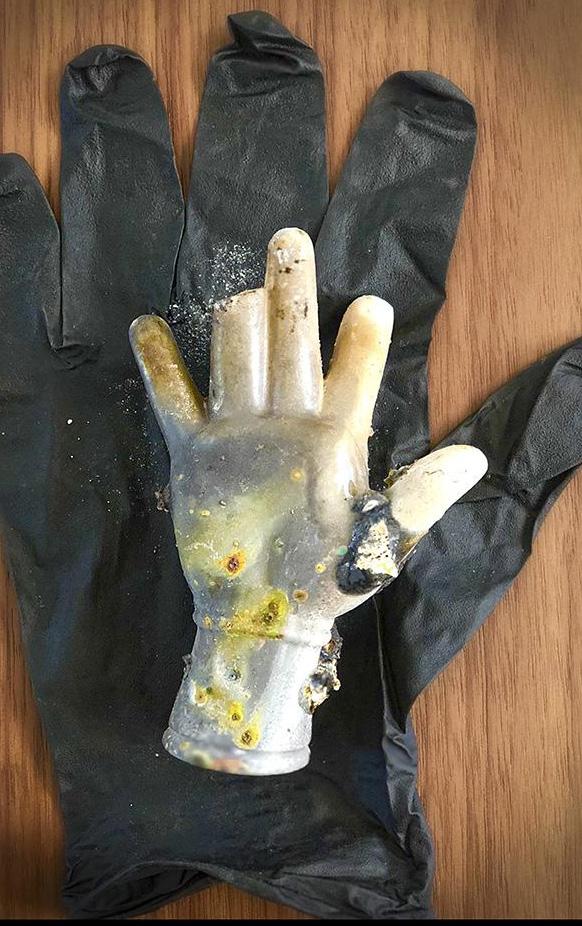
“People, even in seeing something as simple as a glove and an object, can really resonate with people in ways I never imagined,” Quintana said. “And it wasn’t even intentional, it was what I did.”
Erickson said each item was intended to “trigger a memory” of each loss experienced in the blaze.
“We kind of tell our stories by the things that we collect,” Erickson said. “Your memories are triggered by these objects.”
Other photos in the exhibit include ones by Christian Houge that feature taxidermy animals, including an elk, a puma, an eagle, an owl and a wolf. Erickson said Houge wanted to “set them free” by burning and photographing the deceased animals, letting them “move on.”
Photographer Kevin Cooley’s work is also on display. His staged pictures capture controlled burning as well as display those affected, or unaffected, by wildfire.
One titled “Screentime” portrays a young child fixated on a tablet or mobile device, seemingly without knowledge that a roaring fire is happening all around them. Another illustrates people playing basketball while miles away, a mountain is ablaze, but the players don’t seem to pay it any mind.
The exhibit also features photographer Noah Berger. His work includes a gallery of the 2013 Rim Fire outside Yosemite, an event that sparked his interest in fires and capturing their destruction.
Berger follows fires how he pleases and chooses his own assignments based on what fires are happening and what he thinks is newsworthy. He said going near fires doesn’t “feel as dangerous as it looks in the photos.”
The exhibit also includes a short film, titled “California On Fire,” that documents different emotions that come with experiencing fires. The film, made by Jeff Frost, is divided into separate parts, displaying denial, anger, bargaining, sadness and acceptance.
The exhibit has been a long time coming. Erickson said that it takes years to curate a collection like this, with varying artists and art forms used to depict fire and the destruction it brings.
The museum is open on Tuesdays from 10 a.m. to 8 p.m., Wednesday through Friday from 10 a.m. to 5 p.m., and Saturday from 10 a.m. to 3 p.m. The exhibit runs until Dec. 16.
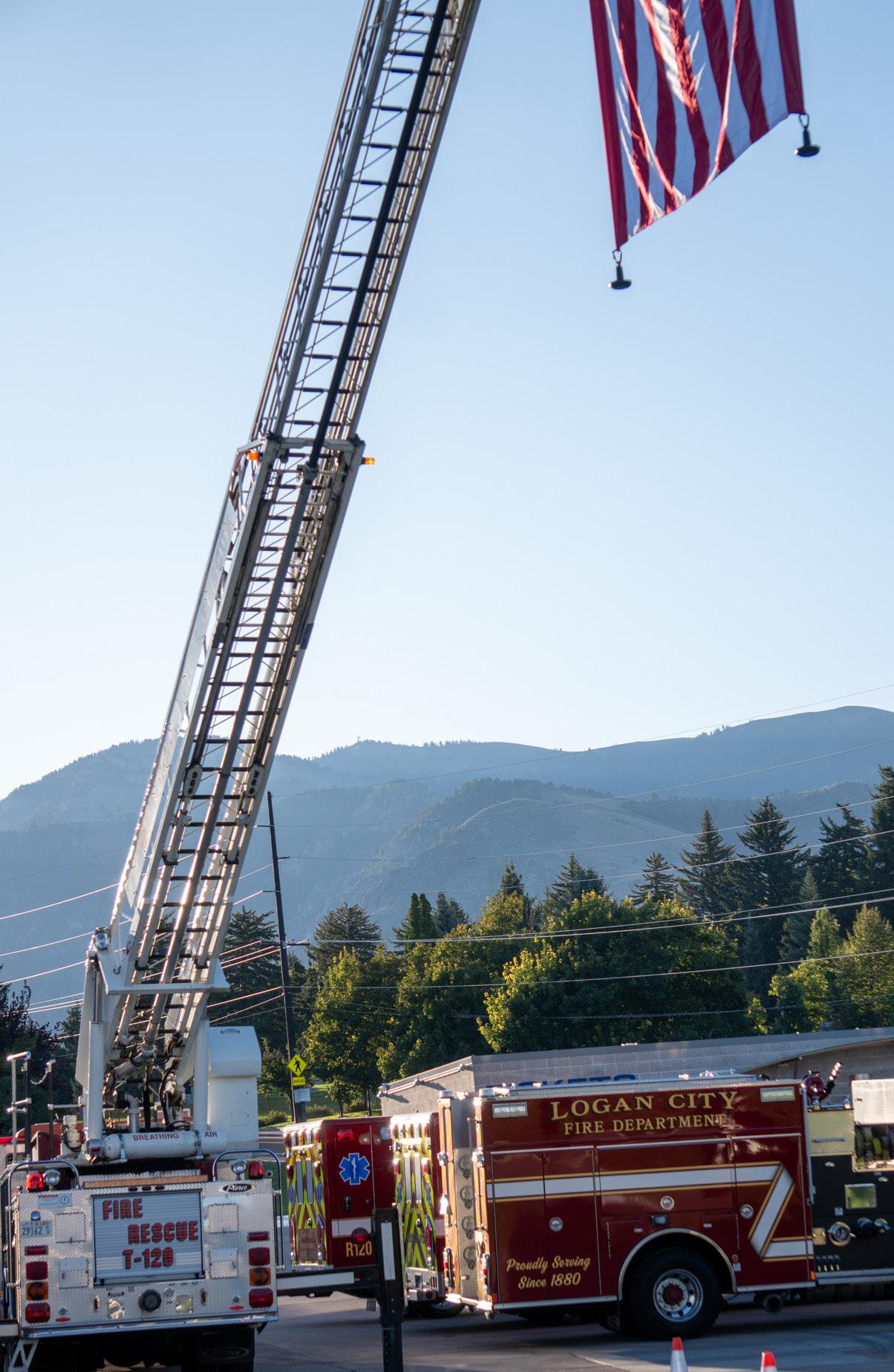
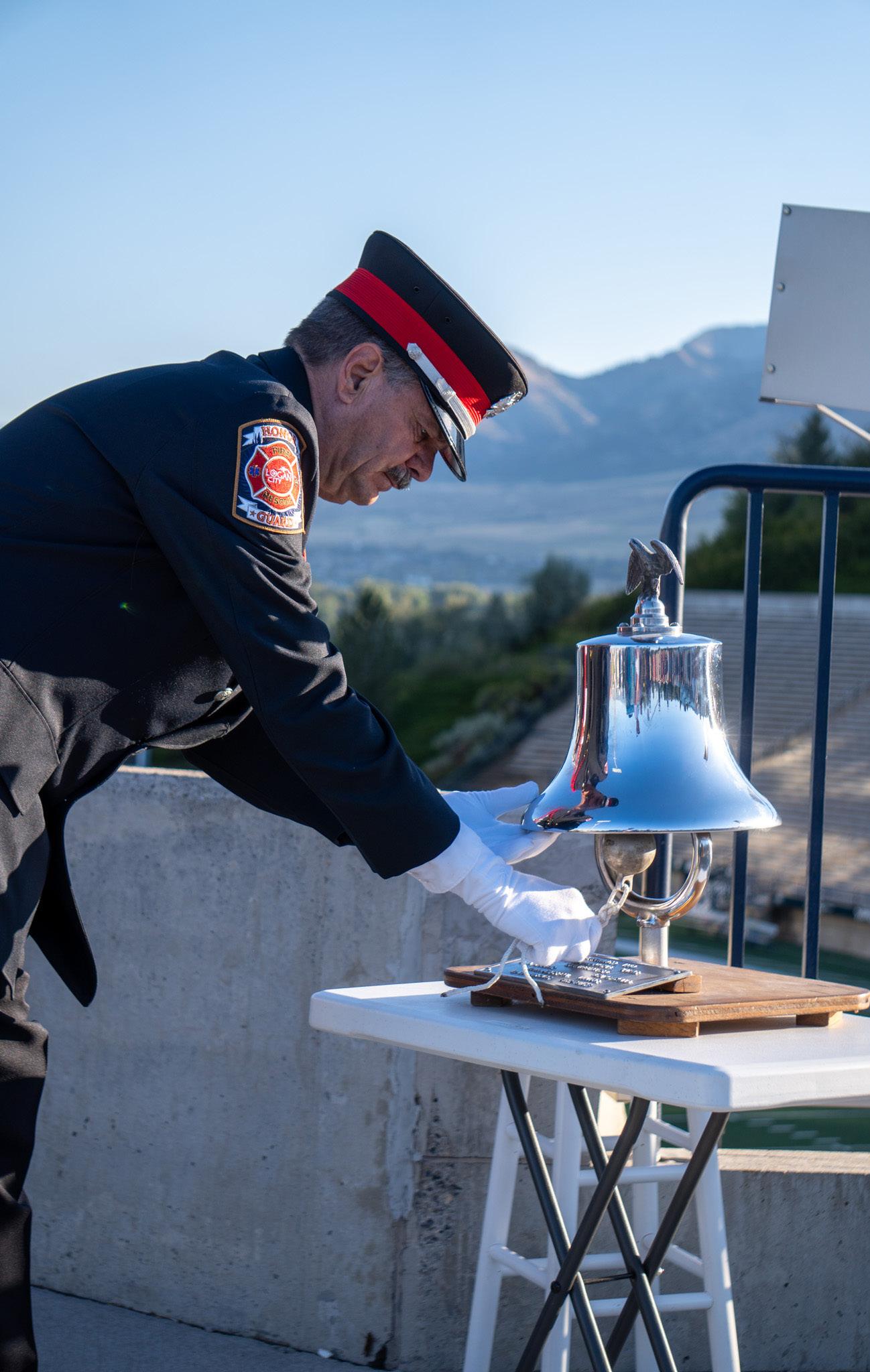
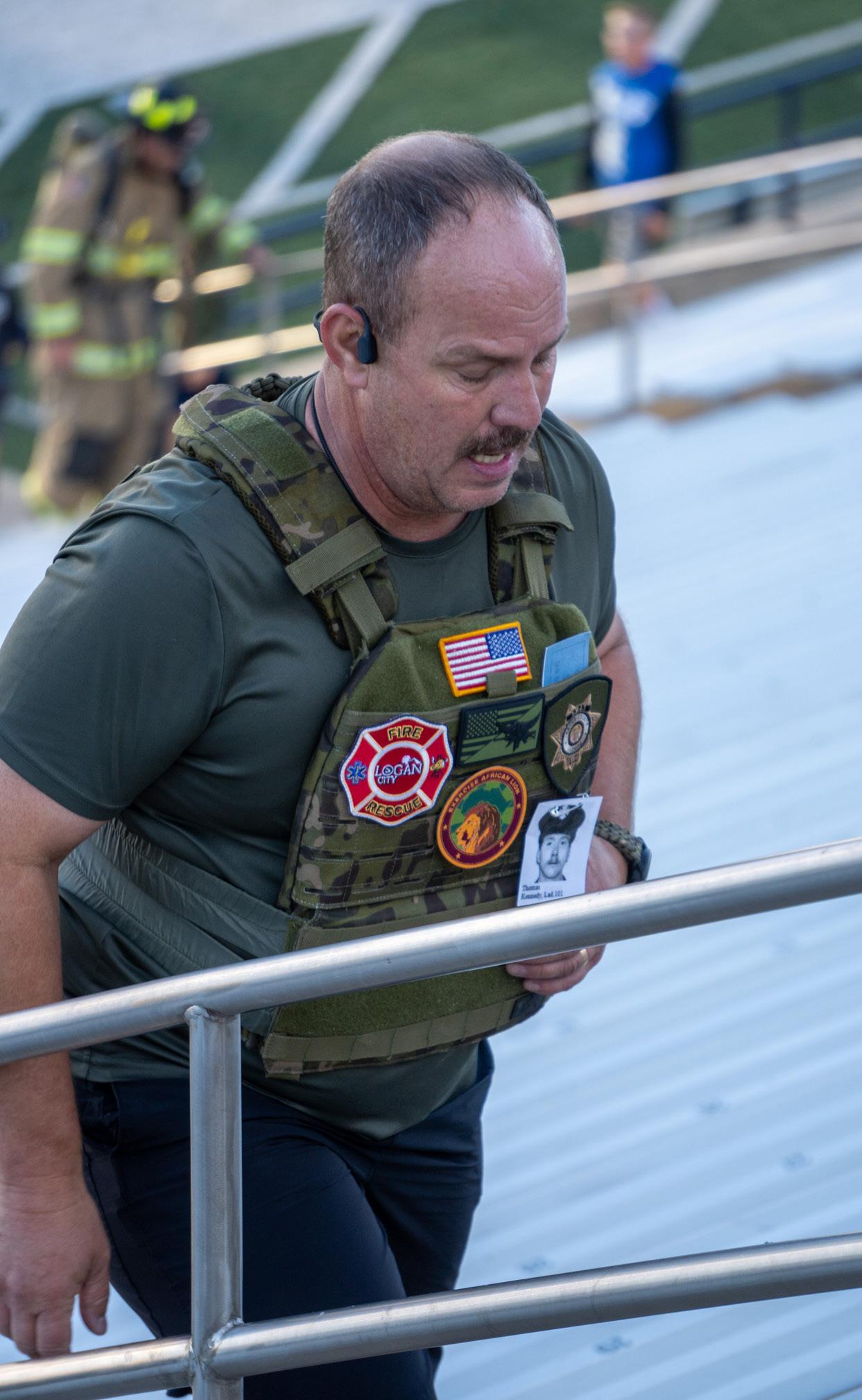


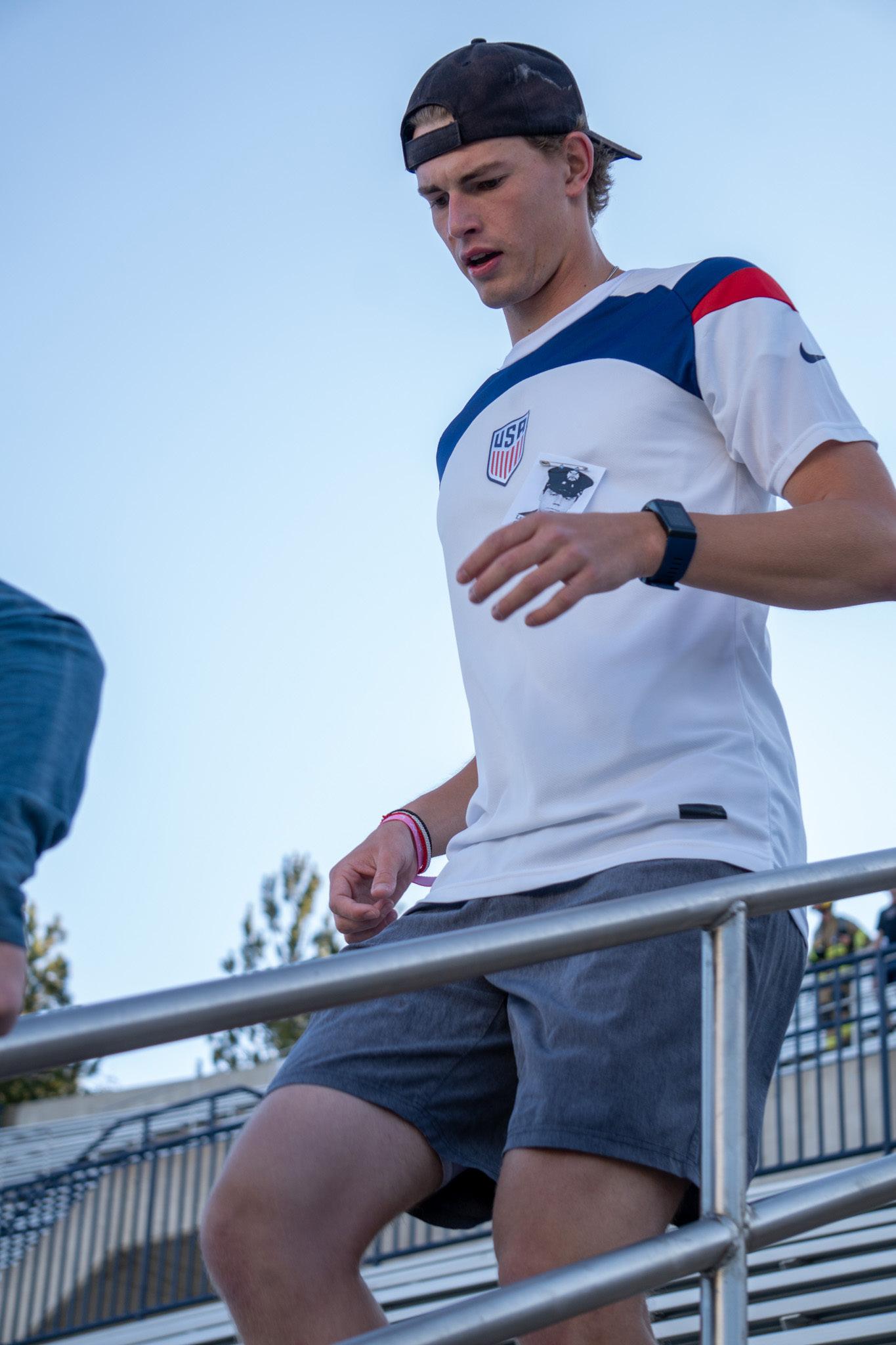
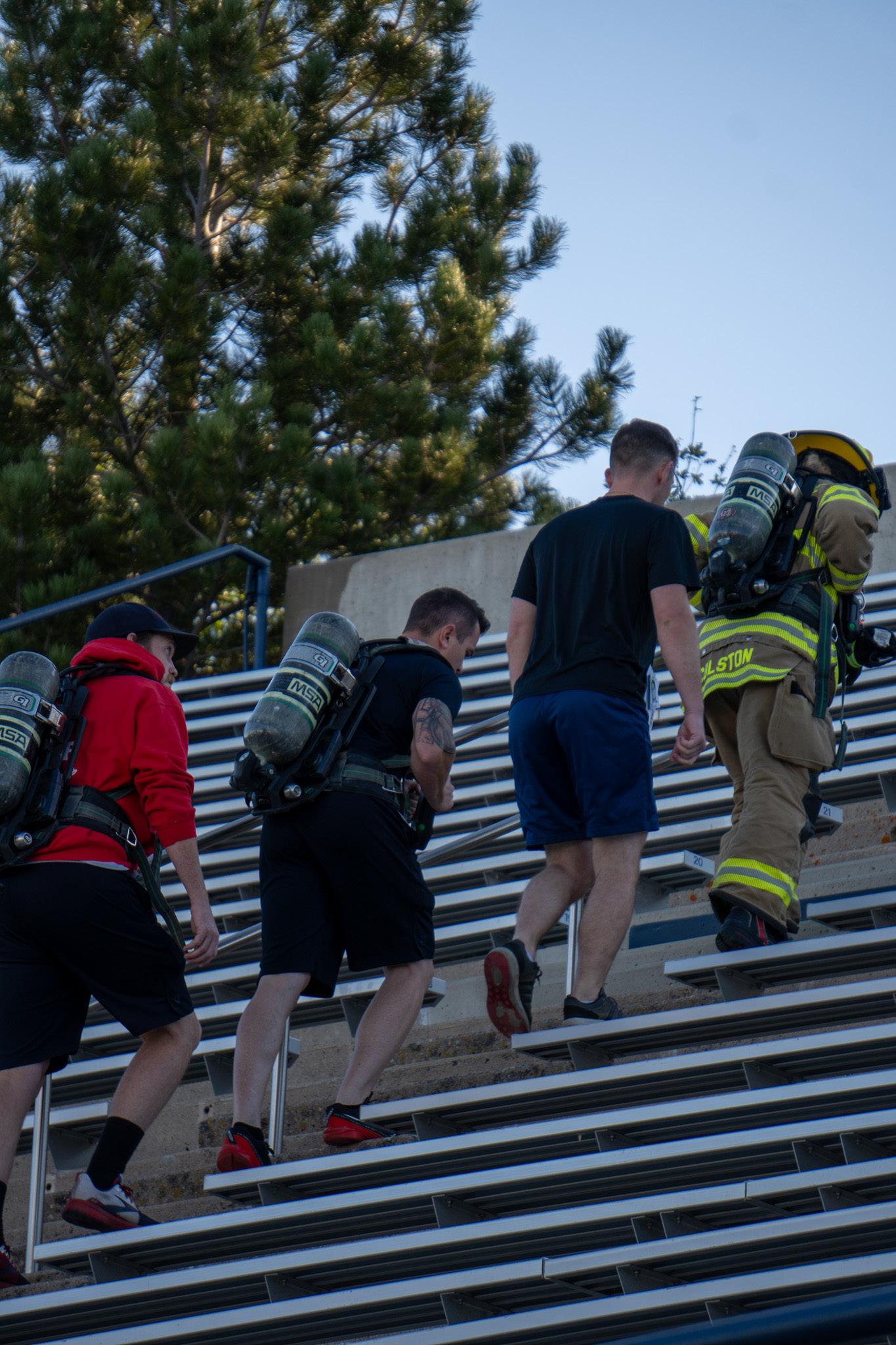 By Madison Weber SPORTS EDITOR
By Madison Weber SPORTS EDITOR
On Sept. 11, 2001, terrorist attacks changed the world forever. When the Twin Towers fell in New York City, first responders came to rescue thousands of affected citizens. Every year on the same day, local servicemen come together to climb the stairs of Maverik Stadium in remembrance of those who risked their lives 22 years ago.
The event has occurred every year since 2002, rain or shine. Up until now, it was only for firefighters and their families. This year marked the first time students, firefighters, servicemen and community members joined together.
“On 9/11, we've always just gotten together as fire departments here at the stadium and run the stairs. This year, we thought, ‘We really should invite USU and their students to their stadium to run with us,’ and we thought that would be special if they could be part of it with us,” said John Cox, a battalion chief for the Logan City Fire Department.
The fire department co-sponsored the event with Utah State Univer-
sity. Other participants included Bridgerland Technical College Fire and Rescue Services and the Cache County, Box Elder County and Rich County fire districts. Local police departments and their dispatchers as well as family members and students were all invited.
Participating firefighters spoke of the importance of remembering the day, particularly for younger generations, even if they weren’t born yet or don’t remember watching it on that day. Some became emotional as they climbed for the lives that were lost.
“Some of the guys were like, ‘I think that might be too much.’ And well, it's a little different for us. I was here at Utah State going to school when 9/11 happened. I think a lot of the students now maybe weren't even born or they were so young, they would never remember it. They appreciate and remember it, but they didn't live through it. This is an event that we lived through, so I want to share that a little bit,” Cox said.
Each participant wore a name and picture of a firefighter who died that day. They were dispatched in companies to one of the symbolic towers.

To heighten the sentiment, the crowd watched a video of the planes crashing and then listened to radio traffic from the firefighter's radios as they climbed.
Firemen in training at Bridgerland Technical College climbed in full uniform, carrying up to 100 pounds of weight, just as the FDNY did.
“We brought gear over here to show the weight that they're carrying, and most of those guys had around 100 pounds worth of gear with them climbing those stairs. We're going to have some of these guys on air, so when their air runs out, you're going to hear their bells start ringing and telling them, ‘You're low on air, you need to get out,’” Cox said. “There’s got to be some emotion to it. That's what we're hoping to capture.”
Each tower had 110 floors, or 2,071 steps. Climbing every stair in the stadium, up and down, equals the same number of stairs in the building that fell.
“25,000 people were evacuated from the buildings by those firefighters. Many didn't make it to the fire floor. They really didn't put it out, you know, but 25,000 people got out because of them,” John said.
Tate Bennett, athletics & campus recreation executive director, partnered with Cox to spread awareness about the event to students.
“We decided the easiest way to market to students and get them involved would be to collaborate with the HURD and the fire department, especially because we're using athletic facilities for it,” Bennett said. “Part of it is for educational purposes. A lot of us grew up in a post-9/11 world without understanding the context of really what’s changed — that’s why it’s important.”
Sarah Winger is a USU student who learned about the event through
the HURD.
“I think it's a good way to remember done for us, especially on 9/11,” she their lives. It's kind of a humbling experience out there are sacrificing their lives every safe, so it means a lot.”
Of the crowd of people gathered at to watch and support, others wanted of appreciation for the lives lost.
ation for those serving in his community.
“I wanted to see like how hard it was stairs they had to do and how long fire and just see how it felt and see what Madison Moore, a student with Fire one of the few students who still remember carry the extra weight around the stadium.
“It's an important day that we should
remember what the first responders have said. “They did this, they sacrificed experience to think that those people every single day for us to keep us at the stadium at 8 a.m., some came wanted to learn more and many did it out with his best friend, whose dad is a 9/11 and gained a newfound appreci-
this opportunity to be able to take a small walk in their shoes is a oncein-a-lifetime chance. I wanted to make sure to be here,” she said.
Moore said she expressed interest in being a firefighter since the age of five. She said it means more being a firefighter now, after the attacks in 2001.
“It's a legacy that you're taking on. And you're not just there for yourself, but you're there for all the firefighters that have come before you, and you're continuing that legacy and also just being that face for people when they're in their scariest moments — being that light for them,” she said.
Many firefighters made phone calls to their spouses on Sept. 11, letting them know they wouldn’t be coming home that night. Cox says it’s part of the job, knowing at any moment you may not make it back to your family.
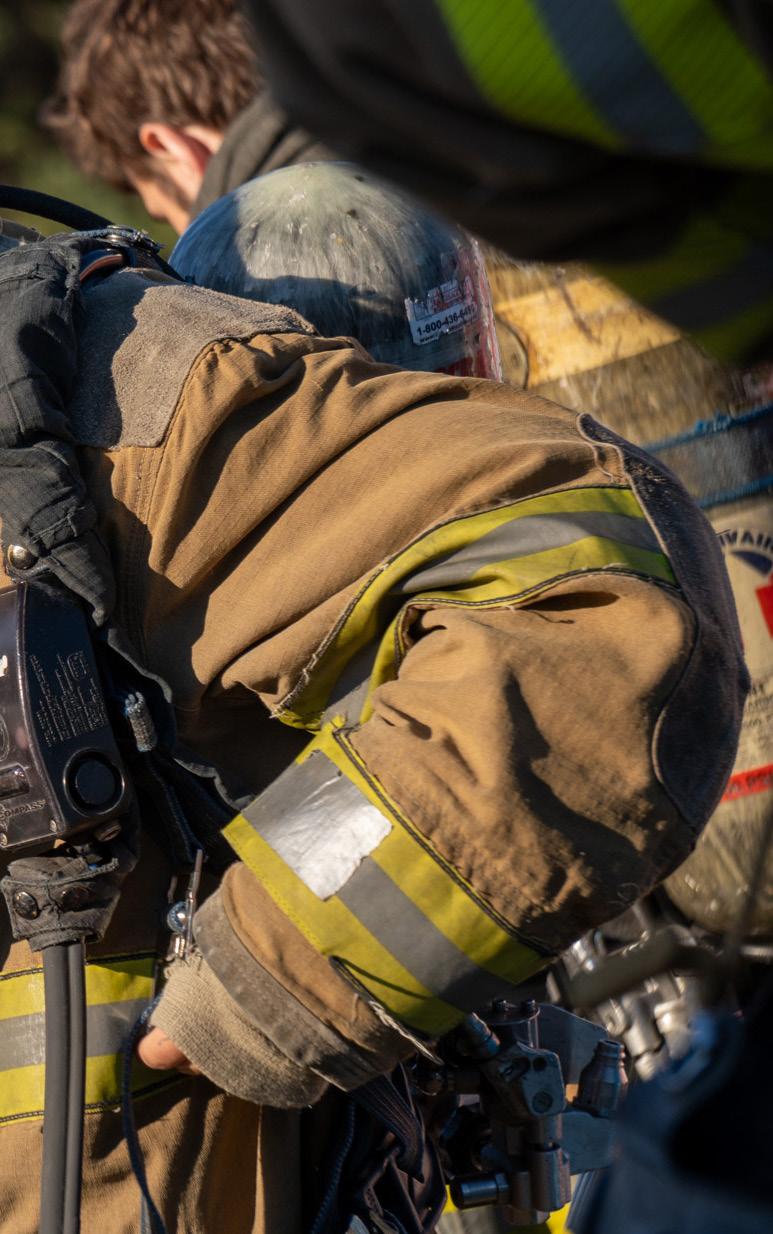
“It's one thing to die for others, it’s another thing to live for others,” Cox said. “I think that's something that we want to celebrate as firefighters.”
Amber Cox, John’s wife, came to support just as she has every year.
“You've got those who remember it happening who are here to remember it, and then you’ve got those that were super young, and they hear their parents talk about it or they vaguely remember something big happening,” she said. “This kind of makes it a little more real. As firemen specifically, they live this — it's more real to them, and so they need to remember.”
Amber became emotional as she spoke of the fear that comes with being the spouse of a firefighter.
“I can't say I know what it's like to lose somebody in a situation like that, because I don't, and I hope I never do. But it does make it real. The reality of knowing that your spouse is putting themselves on the line becomes really personal in situations like this,” she said. “Firemen do this job because they love it. This isn't a 9-5 office kind of job. They live it, they breathe it, they love this job. And if they lose their life doing this job, there's no better way to go. And they truly believe that and spouses have to believe that too. If you lose them in the line, it's the best way to go.”
tance of coming together. It is in our unity, resilience, and the pursuit of a better tomorrow that we truly honor the memory of that tragic day in 2001,” she said. “I hope we all move forward in that spirit and work toward a better tomorrow.”
community.
was for the firefighters,” he said. “The it took for them to actually get to the what they went through,” he said. Fire and Rescue Services, said she is remember 9/11. She was honored to stadium.

should always remember, and getting
As another year passes, John hopes students will remember and appreciate the sacrifice made by so many. After seeing students join, he gained a new excitement for an event they’ve held so many times before.
“We love our students up here. Everybody's so good to us,” John said. “We just want to give back to Utah State and be here with our students, be here with all the good people.”
In a statement from USU President Elizabeth Cantwell, she encouraged the community to unite in memory.
“As we look back on Sept. 11, 2001, do not forget the enduring impor-
-madison.weber@usu.edu @madiweber19

Phil Weber is a senior studying journalism and minoring in marketing and multimedia development. He loves going to the farmers market, walks and eating good food.

— Preston.weber@usu.edu
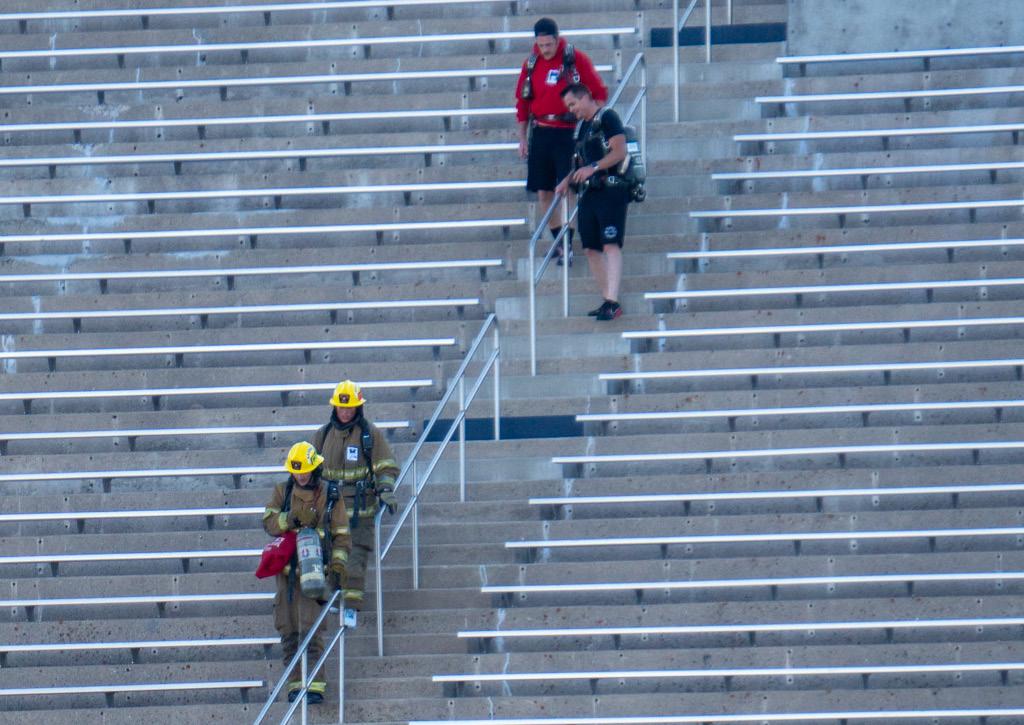

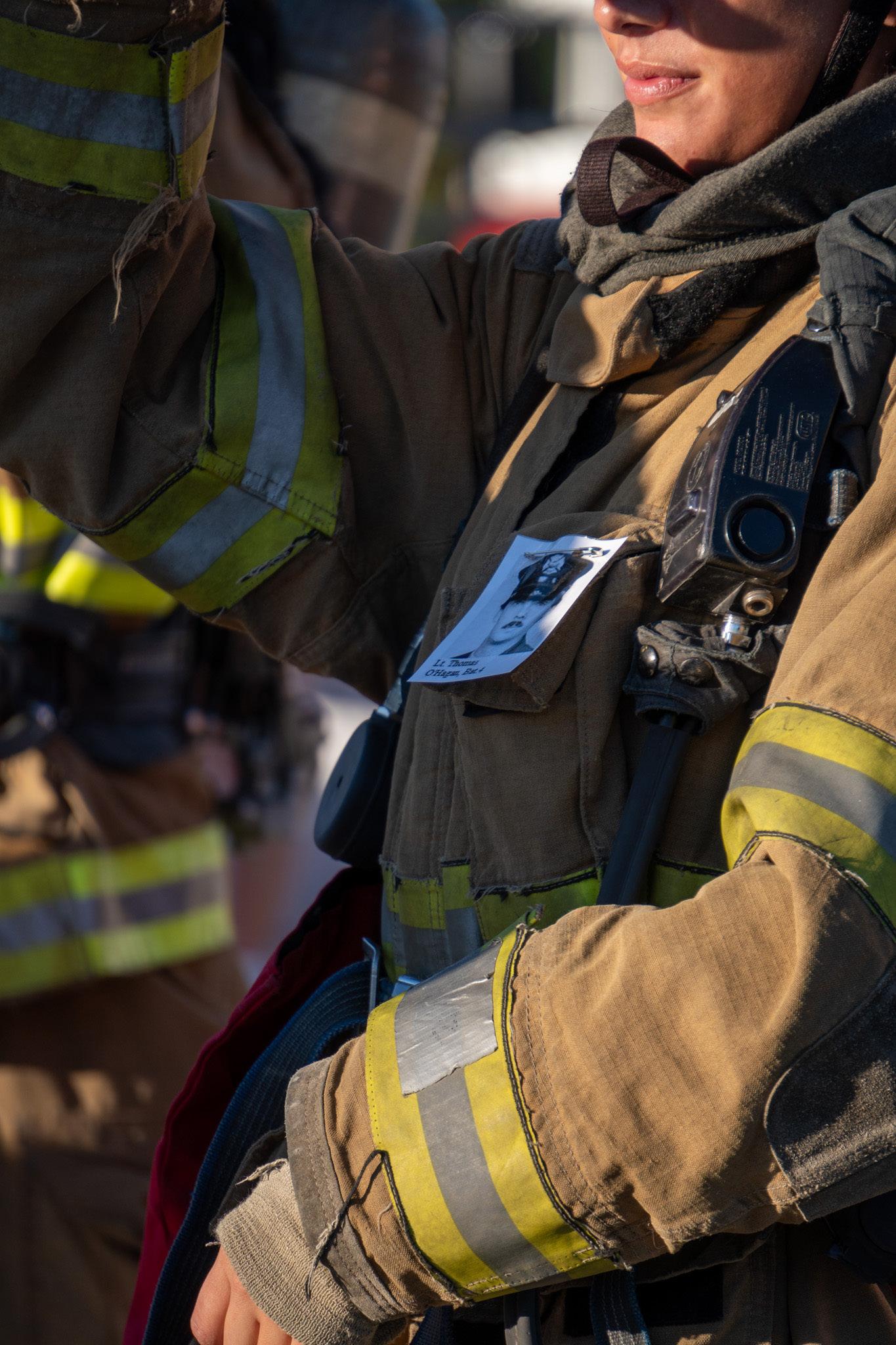

Utah State Football has a new man creating the defensive game plan this year. Defensive coordinator Joe Cauthen was named to the position in February by head coach Blake Anderson. The vacancy was created after former defensive coordinator Ephraim Banda was hired as the safeties coach for the Cleveland Browns.
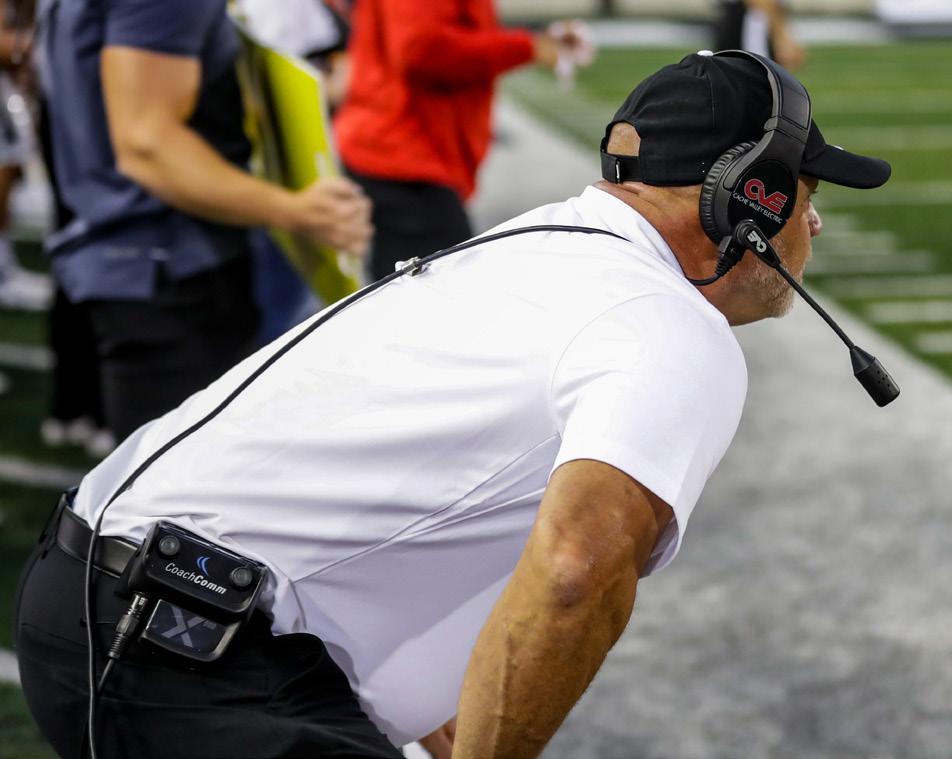
Cauthen joins the program after spending the 2022 season as the defensive coordinator at Stephen F. Austin University, but he was previously on Anderson’s coaching staff at Arkansas State from 2014-2018.
At the fall media day, Anderson expressed losing Banda to Cleveland was difficult, but he was hopeful the familiarity between himself and Cauthen would lead to a smooth transition and show up on the field.
“Joe and I spent a lot of time together — five years at Arkansas State — and have known each other since the late ‘90s. In that sense, there’s some comfort,” Anderson said. “The familiarity with what he does was important especially with me stepping back into the offense, full tilt. That would have been really hard had I not had access to him. He’s exactly who I wanted to hire.”
The decision for Cauthen to leave Stephen F. Austin was also made easier because of his relationship with Anderson.
“I trust Blake and the kind of man he is and what he stands for. At this point in my career, it’s more about who I’m working for,” Cauthen said.
Cauthen brings 27 years of collegiate coaching experience to Logan. Despite such a long career, he still enjoys getting the chance to personally work with student-athletes and develop lifelong relationships at every stop he’s made.
“I just love the challenge every single day of the game. And I also really get a lot of enjoyment at this point in my career seeing success in life after football,” Cauthen said. “I think it’s a platform that God has put me on to help guys, and maybe I can make a difference in one of these young men’s lives.”
Cauthen has experienced his fair share of success on the field as well. Over the course of his career, he
Monday Sept. 18
Cross Country NCAA Regionals Preview AWAY
Wednesday Sept. 20
Men’s club soccer vs. Boise HOME
Thursday Sept. 21
has won five conference championships in addition to a Division II national championship at Valdosta State University.
While coaching with Anderson at Arkansas State, Cauthen led the Red Wolves to two conference championships and five straight bowl wins while the defense ranked in the top 25 nationally in tackles for loss between 2016 and 2018.
Cauthen prides himself on coaching defenses that are aggressive, fast and tough. Through two games against Iowa and Idaho State, both the front seven and defensive backfields have had moments where those traits have been exhibited.
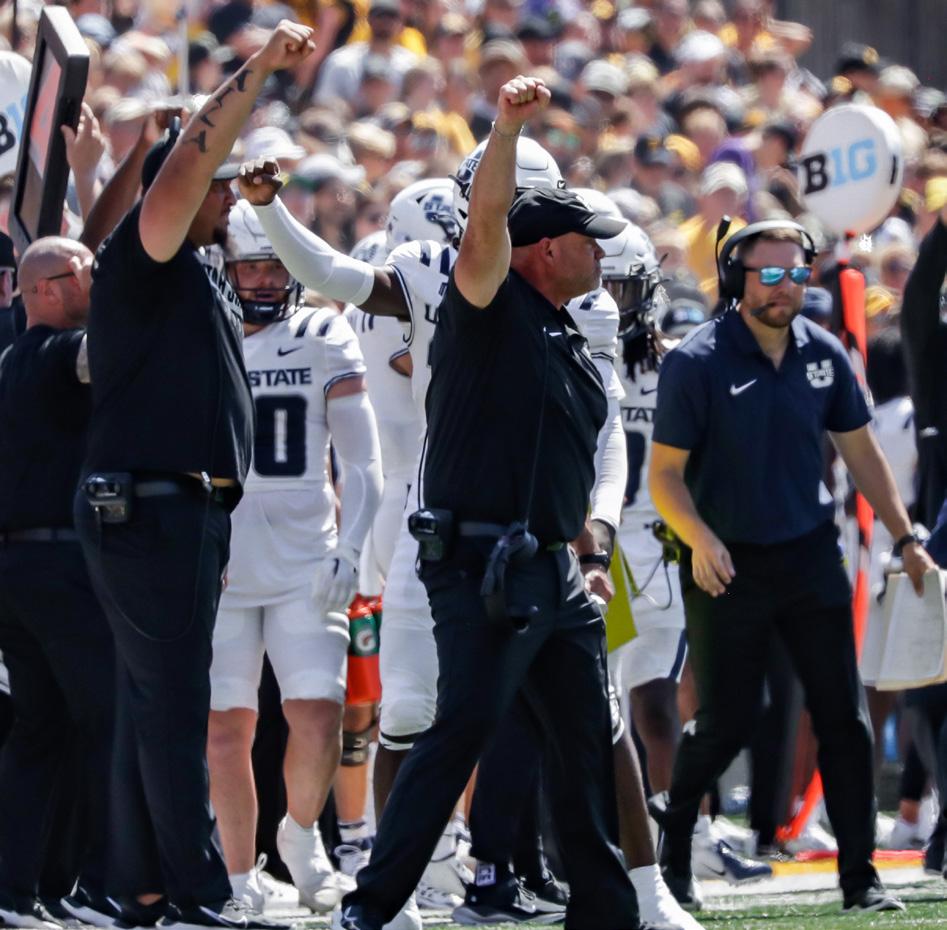
In the Aggies’ loss to Iowa, the defense allowed just 2.4 yards per carry and under 300 total yards of offense. Against Idaho State, the defensive backfield took center-stage, returning two interceptions for touchdowns. When asked what makes this defense different from other ones he has coached, Cauthen praised the versatility and IQ of his players.
“I’ve got some really smart players. They’ve been really easy to coach. Their football IQ is being constantly challenged. I’m giving them the kitchen sink, if you will. And it’s starting to pay rewards because we can we can move players in multiple positions,” Cauthen said. “I’ve been impressed with their ability to handle it in one particular spot, master that spot and then move to another position. It gives us other toys to play with.”
Cauthen and the Aggies hope to build on their strong early season performance in their return to Logan against James Madison University on Saturday, Sept. 23.
Henry Wright is a junior studying political science, American studies and anticipatory intelligence. He loves to travel, watch sports and spend time outdoors.

-henry.wright@usu.edu
Women’s soccer at Air Force AWAY
Women’s volleyball vs. Wyoming HOME
Friday Sept. 22
Women’s tennis at Barb Chandler Classic AWAY
Men’s tennis at Bedford Cup AWAY
Saturday Sept. 23
Women’s club soccer vs. BSU HOME
Men’s club soccer vs. Utah HOME
Women’s volleyball vs. Colorado HOME
Cross Country at Virginia Invitational AWAY
Football vs. James Madison HOME
Sunday Sept. 24
Women’s soccer at Colorado College AWAY
 By Sam Goodman
LIFESTYLES REPORTER
By Sam Goodman
LIFESTYLES REPORTER
Country crooner Katie Mathews grew up in Wellsville, but she didn’t start out singing country music.
Mathews’ performing experience started at the age of 11, when she sang for the Utah Festival Opera. Soon after, she decided she wanted to make a switch in styles, telling her mom, “I love to sing, but I want to sing country.”
Mathews credited artists like Patsy Cline, Lorretta Lynn and LeAnn Rimes with her early love for the sound.
Further in Mathews’ career, the songwriting aspect became a bigger piece to what she would accomplish. Although, as she puts it, she has been writing music since “before I could drive.”
Mathews’ inspiration for her writing comes from life experiences.
She admits to loving “a good man-hating song,” but she credits her four sons and her family for inspiration.
“When I look at what I wrote early in life, midlife and now — it just makes everything rich when you have love like that,” Mathews said.
When Mathews was seventeen, she decided it was time to further her music career and hit the road. She was thrust into the country music scene in Nashville, Tennessee. There, she started a ten-year long stint of the center of the music industry, writing a couple “man-hating songs,” playing gigs and improving her craft.
Mathews credits Nashville for adding to her “new perspectives” and furthering her writing inspiration.

She eventually made her way back to Utah, and she and her band haven’t looked back.
The lead guitarist for the band is Jay Davis, who said he
has played with Mathews for over fifteen years. When Mathews first started performing, Davis was hired on to play for her. He has over thirty years of guitar experience, including playing with the Wasatch Back Band. He said Mathews has “put together a really strong group of musicians.”
The other bandmates include Anderson Safre on guitar, Chris Mortensen on bass and John Bateson on the drums.
Mathews said she is lucky to work with such “amazing musicians.”
Shows canceled due to coronavirus slowed down the band, but this past summer has been “getting back on our feet,” Mathews said.
This summer, they played in Idaho, Wyoming and Utah, including opening for The Bellamy Brothers and Mark Mackay and playing at the National Guard Association. They will continue to play shows into the coming season in local venues and throughout the state.
A soon-to-be-opened venue on Main Street will have the opportunity to provide music and events to residents of Cache Valley. The venue is projected to be ready by the end of the year and will feature the Katie Mathews Band. Mathews said she plays “because I love it.”
“It makes me happy, and I hope everyone does that,” Mathews said. “Find what truly makes them happy and do it.”


Stress-resilient plants have the ability to overcome conditions like drought. These plants are believed to be able to do this through the use of microbes in the roots or soil. Discovering why these plants are resilient could lead to the ability to grow more reliable health food without the use of genetically modified plants.
Amita Kaundal is a researcher and professor with a Ph.D. in life sciences at Utah State University who is conducting a research project concerning microbes in agriculture. Kaundal has a graduate student and an undergraduate student assisting her. The team works closely with native Utah plants and a number of fruit and vegetables such as watermelon, wheat and corn. Similarly to how gut microbes stabilize human bodies, plant microbes can be used to improve plant health.
“In our lab, our main focus is the development of stress resilient crops. With climate change, there are so many incidences of drought and increased salinity,” Kaundal said. “Drought and salinity both are not good for crop production. They directly reduce the production and deteriorate the soil health.”
Kaundal’s goal is to produce stress-resistant plants that can be used as an alternative to genetically modified crops, herbicides and pesticides. Her research is a start to producing healthy and nutritious foods that can grow in harsh conditions.

“Our aim is to identify microbes, test them for production and growth, study crop growth and development to help them mitigate all these abiotic stresses or biotic stresses, and then release them as bio fertilizers for farmers to use to replace chemical fertilizers and also to mitigate the drought and salt stresses in crop production,” Kaundal said.
The research is performed both in the lab and out in the field after sample bacteria is grown for testing and isolated. The bacteria is then combined with soil and a test subject plant, which is carefully observed. For the greenhouse plants, they use soil strata for the field and emulate conditions the plant and bacteria would be facing outdoors.
“Basically what my job is, is to take the soil, dilute it and put it on these Petri dishes and then try to get
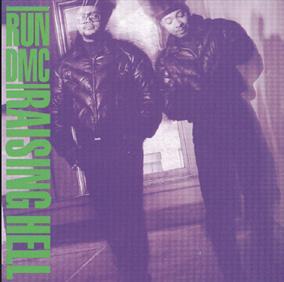


as many of the bacteria and fungus that are present in that soil by themselves,” said Ty Wilson, the undergraduate researcher assisting Kaundal.
The research hasn’t been simple, especially with this year’s grasshopper infestation rampaging through fields and crops. The research team wants to keep their field as chemical-free as possible, so using a pesticide is completely out of the question.
“With the large amount of grasshoppers and locusts we’ve had this year, this summer destroyed our wheat field, and it was lucky we had the opportunity to take some data before they actually came in,” Wilson said.
“We’re not sure if the data is going to be good. We might just have to repeat the experiment next year, which will be unfortunate.”




Despite the damage and potential setback the grasshoppers have caused this year, the team is committed to continuing their research to improve the planet’s health and discover a way to produce food in a more healthy and reliable way.
“We are not only improving the plant health,” Kaundal said. “We are also improving soil health. That’s just motivating me to do it.”
Ray Honahni is the music director for Aggie Radio. When she is not helping out with aggie radio she is usually talking about Foo Fighters or Cardinal Bloom. You can listen to her show Stained Glass Records every Friday at 1 p.m.
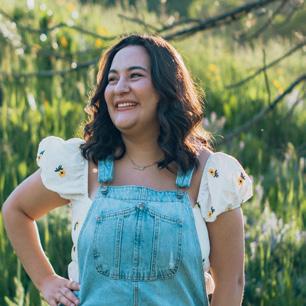

Jacob Casper is majoring in English with an emphasis in creative writing. When he’s not working, he hangs out with his wife. Jacob is an avid hoodie, card and board game collector. All of which are slowly draining him of all funds.

— a02357545@usu.edu



The legend of the giant grizzly, Old Ephraim, dates back to the early 1900s, and Special Collections and Archives at the Merrill-Cazier Library has the bear’s skull. Legend has it Old Ephraim preyed on sheep in the Cache National Forest, which angered local herders. The size of the bear was said to be anywhere between nine and 13 feet, but this was proven to be a misconception.

Many tried to end Old Ephraim’s life, but he always evaded capture. Eventually, a sheep herder, Frank Clark, killed the bear in August 1923, but he later regretted it.
Now, 100 years after Clark killed Old Ephraim, the Special Collections and Archives team has renovated an exhibit from 2019. The exhibit is available now on the main floor of the library, complete with information, as well as artifacts related to the story and the actual size of the bear.
Clint Pumphrey, manuscript curator, was excited to bring the exhibit back to life because he felt it meant something to the residents of Cache Valley.
“I think most kids in Cache County encounter that story at some point,” Pumphrey said. “It’s been told by so many different people.”
According to Pumphrey, USU having the skull of Old Ephraim provides a personal connection between the story and the locals.
“It’s not just a story, because there’s something physical that’s left,” Pumphrey said.
Even though Old Ephraim resided in Cache County, the skull wasn’t always held at USU. In fact, the first people in possession of it were the group of Boy Scouts who dug up the remains.
“They sent the skull to the Smithsonian Institution in Washington, D.C., where it stayed for over 50 years,” Pumphrey said.
The Smithsonian didn’t display Old Ephraim, so Orrin Hatch — Utah’s senator at the time — was able to retrieve the skull and loan it to USU. “He actually flew a helicopter to the Quad of USU with a box with the skull in it,” Pumphrey said. “It goes to show how meaningful it is that the senator would bring it in like that to the president.”
Devin Greener, preservation lab coordinator and exhibitions committee chair, worked closely with the College of Natural Resources to put together the current exhibit.
“They sent the bear skull replica, the whole case
of bear facts and bear footprints,” Greener said.
Greener also worked with Patsy Palacios, director of the Mason Wildlife Exhibit at the Quinney Natural Resources Library.
“She was so generous with her time and with her resources,” Greener said. “And they were super great to work with.”
The Old Ephraim exhibit doesn’t just educate students and Cache County residents alike, but it also provides a gateway for students to learn about Special Collections and Archives in general.
“They see the bear skull, and then they might ask about other things that we have,” Pumphrey said. “Almost everything we have is intrinsically interesting.”
Apart from Old Ephraim, Special Collections and Archives typically collects history documents, books and photographs of the region.
“It’s fun to be able to work with those materials and share them with the students, faculty and community,” Pumphrey said.
“That starts a conversation that maybe leads to someone’s passion and research using our materials,” Greener said. “You just never know how it will grow.”
The exhibit will be available through Sept. 25, but the skull is always available to see in the Special Collections and Archives office, which is on the lower level of the Merrill-Cazier Library.
There is also a digital exhibit available with more information at exhibits.usu.edu/exhibits/show/oldephraim.
Ella Stott is a freshman studying English and journalism because she hates money. When she’s not writing, she’s watching sitcoms, eating Greek yogurt and admiring Nebraska corn outdoors.

Sudoku puzzles are provided by www.sudokuoftheday.com.











Last week’s solution:



